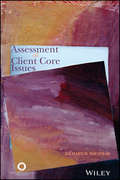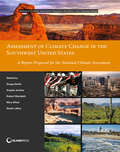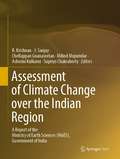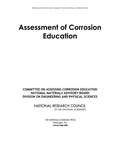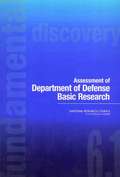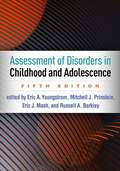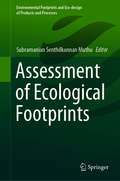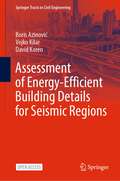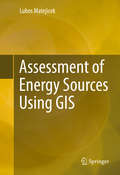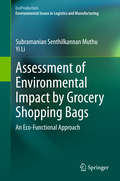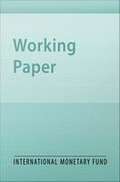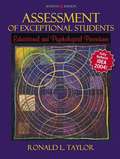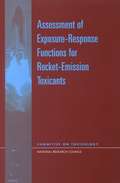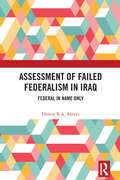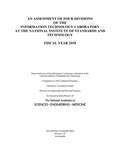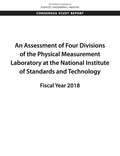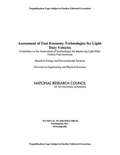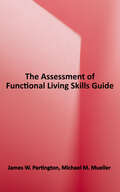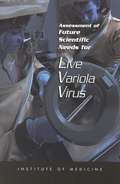- Table View
- List View
Assessment of Client Core Issues
by Richard W. HalsteadThis monograph instructs counselors on how to better recognize, understand, and treat clients’ underlying problems. The model presented helps uncover the origin of these core concerns, provides a means to address them, and challenges counselors to move beyond the DSM to better serve their clients. This framework will also assist counselors in providing more targeted treatment plans. *Requests for digital versions from the ACA can be found on wiley.com. *To request print copies, please visit the ACA website.
Assessment of Climate Change in the Southwest United States: A Report Prepared for the National Climate Assessment (NCA Regional Input Reports)
by Gregg Garfin Mary Black Sarah Leroy Angela Jardine Robert MeridethPrepared for the 2013 National Climate Assessment and a landmark study in terms of its breadth and depth of coverage, this report blends the contributions of 120 experts in climate science, economics, ecology, engineering, geography, hydrology, planning, resources management, and other disciplines to provide the most comprehensive, and understandable, analysis to date about climate and its effects on the people and landscapes of Arizona, California, Colorado, Nevada, New Mexico, and Utah--including the U. S. -Mexico border region and the lands of Native Nations. What is the climate of the Southwest like today? What has it been like in the past, and how is it projected to change over the 21st century? How will that affect water resources, ecosystems, agricultural production, energy supply and delivery, transportation, human health, and a host of other areas? How vulnerable is the region to climate change? What else do we need to know about it, and how can we limit its adverse effects?In addressing these and other questions, the book offers decision makers and stakeholders a substantial basis from which to make informed choices that will affect the well-being of the region's inhabitants in the decades to come.
Assessment of Climate Change over the Indian Region: A Report of the Ministry of Earth Sciences (MoES), Government of India
by R. Krishnan J. Sanjay Chellappan Gnanaseelan Milind Mujumdar Ashwini Kulkarni Supriyo ChakrabortyThis open access book discusses the impact of human-induced global climate change on the regional climate and monsoons of the Indian subcontinent, adjoining Indian Ocean and the Himalayas. It documents the regional climate change projections based on the climate models used in the IPCC Fifth Assessment Report (AR5) and climate change modeling studies using the IITM Earth System Model (ESM) and CORDEX South Asia datasets. The IPCC assessment reports, published every 6–7 years, constitute important reference materials for major policy decisions on climate change, adaptation, and mitigation. While the IPCC assessment reports largely provide a global perspective on climate change, the focus on regional climate change aspects is considerably limited. The effects of climate change over the Indian subcontinent involve complex physical processes on different space and time scales, especially given that the mean climate of this region is generally shaped by the Indian monsoon and the unique high-elevation geographical features such as the Himalayas, the Western Ghats, the Tibetan Plateau and the adjoining Indian Ocean, Arabian Sea, and Bay of Bengal. This book also presents policy relevant information based on robust scientific analysis and assessments of the observed and projected future climate change over the Indian region.
Assessment of Commercial Space Platforms for Earth Science Instruments: Report Series?committee On Earth Science And Applications From Space
by National Academies of Sciences, Engineering, and Medicine Division on Engineering and Physical Sciences Space Studies Board Committee on Earth Science and Applications from SpaceSpace-based Earth observations enable global observations of the land surface, biosphere, solid Earth, atmosphere, cryosphere, and oceans. Earth observations from space, combined with data acquired from in situ and ground-based instruments, help scientists understand the components of the Earth system and their interactions and enable wide-ranging applications, including forecasts of weather and air quality, projections of future climate, management of natural resources, ecological forecasting, disaster management, drought and wildfire prediction, and the mapping and prediction of vector borne/animal diseases. At the request of NASA Earth Science Division, this report assesses the potential use of a proposed multi-user, robot-tended, uncrewed commercial space platform as a potential host for a large number of Earth remote sensing instruments. Assessment of Commercial Space Platforms for Earth Science Instruments evaluates the utility and practicality of a platform in a Sun-synchronous orbit, capable of hosting 20 or more instruments.
Assessment Of Corrosion Education
by National Research Council of the National AcademiesThe threat from the degradation of materials in the engineered products that drive our economy, keep our citizenry healthy, and keep us safe from terrorism and belligerent threats has been well documented over the years. And yet little effort appears to have been made to apply the nation's engineering community to developing a better understanding of corrosion and the mitigation of its effects. The engineering workforce must have a solid understanding of the physical and chemical bases of corrosion, as well as an understanding of the engineering issues surrounding corrosion and corrosion abatement. Nonetheless, corrosion engineering is not a required course in the curriculum of most bachelor degree programs in MSE and related engineering fields, and in many programs, the subject is not even available. As a result, most bachelor-level graduates of materials- and design-related programs have an inadequate background in corrosion engineering principles and practices. To combat this problem, the book makes a number of short- and long-term recommendations to industry and government agencies, educational institutions, and communities to increase education and awareness, and ultimately give the incoming workforce the knowledge they need.
An Assessment of Data, Tools, and Metrics for Equity in Decisions About Surface Transportation Investments
by National Academies of Sciences, Engineering, and Medicine Transportation Research Board Consensus and Advisory Studies Division Committee on Data, Metrics, and Analytic Methods for Assessing Equity Impacts of Surface Transportation Investments: Phase 2 Study to Support State and Local Decision MakingThe U.S. Department of Transportation and Congress should direct and support states, localities, regional planning organizations, and other recipients of federal surface transportation funds to pilot test the use of metrics for informing transportation investments aimed at addressing the needs of all people in a deliberate and equitable manner. This is among the recommendations in TRB Special Report 356: An Assessment of Data, Tools, and Metrics for Equity in Decisions About Surface Transportation Investments, from the Transportation Research Board of the National Academies of Sciences, Engineering, and Medicine. The report, called for by Congress, considers the needs of state and local jurisdictions as they strive to use their federal transportation funds to promote safe and reliable access to life needs such as housing, jobs, health care, and education, and to avoid and mitigate any adverse effects from transportation. The report’s findings and advice will also inform a follow-on National Academies’ research project to pilot test promising approaches for equity analysis.
Assessment of Department of Defense Basic Research
by National Research Council of the National AcademiesThe Department of Defense (DOD) supports basic research to advance fundamental knowledge in fields important to national defense. Over the past six years, however, several groups have raised concern about whether the nature of DOD-funded basic research is changing. The concerns include these: Funds are being spent for research that does not fall under DOD's definition of basic research; reporting requirements have become cumbersome and onerous; and basic research is handled differently by the three services. To explore these concerns, the Congress directed DOD to request a study from the National Research Council (NRC) about the nature of basic research now being funded by the Department. Specifically the NRC was to determine if the programs in the DOD basic research portfolio are consistent with the DOD definition of basic research and with the characteristics associated with fundamental research.
Assessment of Disorders in Childhood and Adolescence
by Eric A. Youngstrom Mitchell J. Prinstein Eric J. Mash Russell A. BarkleyThis leading course text and practitioner reference has been extensively revised with 90% new content, covering a broader range of child and adolescent problems in more concise chapters. Prominent authorities provide a comprehensive framework for evidence-based assessment. Presented are methods and tools for developing effective diagnoses and case formulations, building strong treatment plans, monitoring progress, and documenting outcomes. Chapters are packed with practical guidance, handy tables, and sample instruments. Illustrative case material is included. Prior edition title: Assessment of Childhood Disorders, Fourth Edition, edited by Eric J. Mash and Russell A. Barkley.
Assessment of Eating Disorders
by James Mitchell Carol B. PetersonConcise and practical yet comprehensive, this unique book provides a clear framework and a range of up-to-date tools for assessing patients with eating disorders. Leading clinicians and researchers describe the nuts and bolts of using diagnostic interviews, standardized databases, structured instruments, self-report and family-based measures, medical and nutritional assessment, ecological momentary assessment, and strategies for evaluating body image disturbance. Concrete examples and sample forms are included throughout, and the concluding chapter discusses how to use assessment data in individualized treatment planning.
Assessment of Ecological Footprints (Environmental Footprints and Eco-design of Products and Processes)
by Subramanian Senthilkannan MuthuThis book highlights the concepts and assessment methods of Ecological Footprints. Ecological footprint is defined as, ”a measure of how much area of biologically productive land and water an individual, population or activity requires to produce all the resources it consumes and to absorb the waste it generates, using prevailing technology and resource management practices”. Developed in 1992 by William Rees, it was the first footprint developed followed by other footprints such as Carbon, Water and Energy. Assessment of Ecological footprints strive for comparing consumption footprint to biological capacity. This book presents five interesting chapters pertaining to the assessment of Ecological Footprints.
Assessment of Energy-Efficient Building Details for Seismic Regions (Springer Tracts in Civil Engineering)
by Boris Azinović Vojko Kilar David KorenThis open access book presents a methodology for the assessment of structural building details, taking into account the contemporary guidelines for earthquake-resistant and energy-efficient buildings. A review of structural details for energy-efficient buildings revealed that in some cases the structural system is interrupted, leading to solutions which are not suitable for earthquake-prone regions. Such typical examples would be the use of thermal insulation under the building foundation and reduction of the load-bearing elements’ dimensions – also at the potential locations of plastic hinges which are crucial for the dissipation of seismic energy. The proposed methodology of assessment favours a collaboration of architects, engineers, contractors and investors in the early stage of building design. By this the methodology enables efficient decision-making and contributes to a selection of optimal building structural details.The book starts by presenting the typical structural details of the thermal envelope of energy-efficient buildings together with the scientific background required for understanding the process of detail development from all the relevant aspects. Over 20 examples of most frequent details are described and analysed to raise awareness of the importance of earthquake resistance, sustainability, energy-efficiency and thermal comfort for users.
Assessment of Energy Sources Using GIS
by Lubos MatejicekThis volume is a comprehensive guide to the use of geographic information systems (GIS) for the spatial analysis of supply and demand for energy in the global and local scale. It gathers the latest research and techniques in GIS for spatial and temporal analysis of energy systems, mapping of energy from fossil fuels, optimization of renewable energy sources, optimized deployment of existing power sources, and assessment of environmental impact of all of the above. Author Lubos Matejicek covers GIS for assessment a wide variety of energy sources, including fossil fuels, hydropower, wind power, solar energy, biomass energy, and nuclear power as well as the use of batteries and accumulators. The author also utilizes case studies to illustrate advanced techniques such as multicriteria analysis, environmental modeling for prediction of energy consumption, and the use of mobile computing and multimedia tools.
Assessment of Environmental Impact by Grocery Shopping Bags: An Eco-Functional Approach (EcoProduction)
by Yi Li Subramanian Senthilkannan MuthuThis book reviews the manufacturing processes of different shopping bags used for grocery purposes, life cycle impacts, modelling of life cycle impacts, carbon and eco-footprints in different countries, consumption of shopping bags in different countries, consumer behaviour of shopping bags in various countries and its relation to eco-impact, assessment of functionality of shopping bags, concept and framework of eco-functional assessment of shopping bags, biodegradation of shopping bags, etc.
An Assessment of Estimates of Term Structure Models for the United States
by Ying He Carlos MedeirosA report from the International Monetary Fund.
Assessment of Exceptional Students: Educational and Psychological Procedures (7th edition)
by Ronald L. TaylorThis update of the 2003 text treats the role of assessment in recent US laws (e.g., the Individuals with Disabilities Education Act-- IDEA 2004, No Child Left Behind Act) and new/revised tests. In introducing practical and ethical assessment issues, Taylor (Florida Atlantic U.) traces historical events, philosophical movements, legislation, and legal cases involving assessment. He proposes a model comprised of pre- and post-referral components that meet many states' requirements, and presents vignettes for discussion. Appendices include descriptions of instruments used for measuring processing skills, traumatic brain injury, specific target behaviors, and cognitive aspects of special populations. Previous editions appeared between 1984 and 2000. Annotation ©2005 Book News, Inc., Portland, OR (booknews.com)
Assessment Of Explosive Destruction Technologies For Specific Munitions At The Blue Grass And Pueblo Chemical Agent Destruction Pilot Plants
by National Research Council of the National AcademiesThe Army's ability to meet public and congressional demands to destroy expeditiously all of the U.S. declared chemical weapons would be enhanced by the selection and acquisition of appropriate explosive destruction technologies (EDTs) to augment the main technologies to be used to destroy the chemical weapons currently at the Blue Grass Army Depot (BGAD) in Kentucky and the Pueblo Chemical Depot (PCD) in Colorado. The Army is considering four EDTs for the destruction of chemical weapons: three from private sector vendors, and a fourth, Army-developed explosive destruction system (EDS). This book updates earlier evaluations of these technologies, as well as any other viable detonation technologies, based on several considerations including process maturity, process efficacy, process throughput, process safety, public and regulatory acceptability, and secondary waste issues, among others. It also provides detailed information on each of the requirements at BGAD and PCD and rates each of the existing suitable EDTs plus the Army's EDS with respect to how well it satisfies these requirements.
Assessment of Exposure-Response Functions for Rocket-Emission Toxicants
by Subcommittee on Rocket-Emission ToxicantsThe U.S. Air Force is developing a model to assist commanders in determining when it is safe to launch rocket vehicles. The model estimates the possible number and types of adverse health effects for people who might be exposed to the ground cloud created by rocket exhaust during a normal launch or during an aborted launch that results in a rocket being destroyed near the ground.Assessment of Exposure-Response Functions for Rocket-Emmission Toxicants evaluates the model and the data used for three rocket emission toxicants: hydrogen chloride, nitrogen dioxide, and nitric acid.
An Assessment of External Price Competitiveness for Mozambique
by Francis VitekA report from the International Monetary Fund.
Assessment of Failed Federalism in Iraq: Federal in Name Only
by Hemin R.A. AkreyiAkreyi investigates the development of federal relations in Iraq from the adoption of the new Federal Constitution in 2005 to the Kurdistan independence referendum in 2017.The book highlights the dysfunctionality of the Iraqi federal system even after the independence referendum and shows the true picture of the key issues between the Kurdistan Region and the Iraqi government in Baghdad. This informative content is presented in an easy-to-grasp manner, originating primarily from face-to-face interviews with relevant elites and decision-makers in Iraq as well as foreign diplomats.A valuable source for academics, researchers, journalists, and students of politics and international relations at the undergraduate and postgraduate levels in all universities, especially in the West and Middle East.
An Assessment of Fiscal Rules in the United Kingdom
by Michael KellA report from the International Monetary Fund.
An Assessment of Four Divisions of the Information Technology Laboratory at the National Institute of Standards and Technology: Fiscal Year 2018
by National Academies of Sciences Engineering MedicineAn Assessment of Four Divisions of the Information Technology Laboratory at the National Institute of Standards and Technology: Fiscal Year 2018 assesses the scientific and technical work performed by four divisions of the National Institute of Standards and Technology (NIST) Information Technology Laboratory. This publication reviews technical reports and technical program descriptions prepared by NIST staff and summarizes the findings of the authoring panel.
An Assessment of Four Divisions of the Physical Measurement Laboratory at the National Institute of Standards and Technology: Fiscal Year 2018
by National Academies of Sciences Engineering MedicineAn Assessment of Four Divisions of the Physical Measurement Laboratory at the National Institute of Standards and Technology: Fiscal Year 2018 assesses the scientific and technical work performed by four divisions of the National Institute of Standards and Technology (NIST) Physical Measurement Laboratory. This publication reviews technical reports and technical program descriptions prepared by NIST staff and summarizes the findings of the authoring panel.
Assessment of Fuel Economy Technologies for Light-Duty Vehicles
by National Research Council of the National AcademiesVarious combinations of commercially available technologies could greatly reduce fuel consumption in passenger cars, sport-utility vehicles, minivans, and other light-duty vehicles without compromising vehicle performance or safety. Assessment of Technologies for Improving Light Duty Vehicle Fuel Economy estimates the potential fuel savings and costs to consumers of available technology combinations for three types of engines: spark-ignition gasoline, compression-ignition diesel, and hybrid. According to its estimates, adopting the full combination of improved technologies in medium and large cars and pickup trucks with spark-ignition engines could reduce fuel consumption by 29 percent at an additional cost of $2,200 to the consumer. Replacing spark-ignition engines with diesel engines and components would yield fuel savings of about 37 percent at an added cost of approximately $5,900 per vehicle, and replacing spark-ignition engines with hybrid engines and components would reduce fuel consumption by 43 percent at an increase of $6,000 per vehicle. The book focuses on fuel consumption--the amount of fuel consumed in a given driving distance--because energy savings are directly related to the amount of fuel used. In contrast, fuel economy measures how far a vehicle will travel with a gallon of fuel. Because fuel consumption data indicate money saved on fuel purchases and reductions in carbon dioxide emissions, the book finds that vehicle stickers should provide consumers with fuel consumption data in addition to fuel economy information.
The Assessment of Functional Living Skills Guide
by James W. Partington Michael M. MuellerThe AFLS Guide provides information about the features of the AFLS, how to correctly score items, and how to develop program goals and objectives that clearly define and target the needs of the learner. - The AFLS Guide provides assessment and scoring instructions for each module - Includes recommendations for creating a unique, functional skills program - Functional, adaptive, self-help, practical life skills to maximize independence - Appropriate for children, adolescents, and adults in the home, school, and community setting - Structure of the assessment and skills tracking grid similar to the ABLLS-R - Easy to use for parents, teachers, behavior therapists, and other caregivers.
Assessment of Future Scientific Needs for Live Variola Virus
by Institute of MedicineIn 1980, the World Health Organization (WHO) officially declared that smallpox had been eradicated. In 1986, WHO's international Ad Hoc Committee on Orthopox Virus Infections unanimously recommended destruction of the two remaining official stocks of variola virus, one at the Centers for Disease Control and Prevention and the other at the VECTOR laboratory in Siberia. In June 1999, WHO decided to delay the destruction of these stocks. Informing that decision was Assessment of Future Scientific Needs for Variola Virus, which examines:-- Whether the sequenced variola genome, vaccinia, and monkey pox virus are adequate for future research or whether the live variola virus itself is needed to assist in the development of antiviral therapies.-- What further benefits, if any, would likely be gained through the use of variola in research and development efforts related to agent detection, diagnosis, prevention, and treatment.-- What unique potential benefits, if any, the study of variola would have in increasing our fundamental understanding of the biology, host-agent interactions, pathogenesis, and immune mechanisms of viral diseases.
